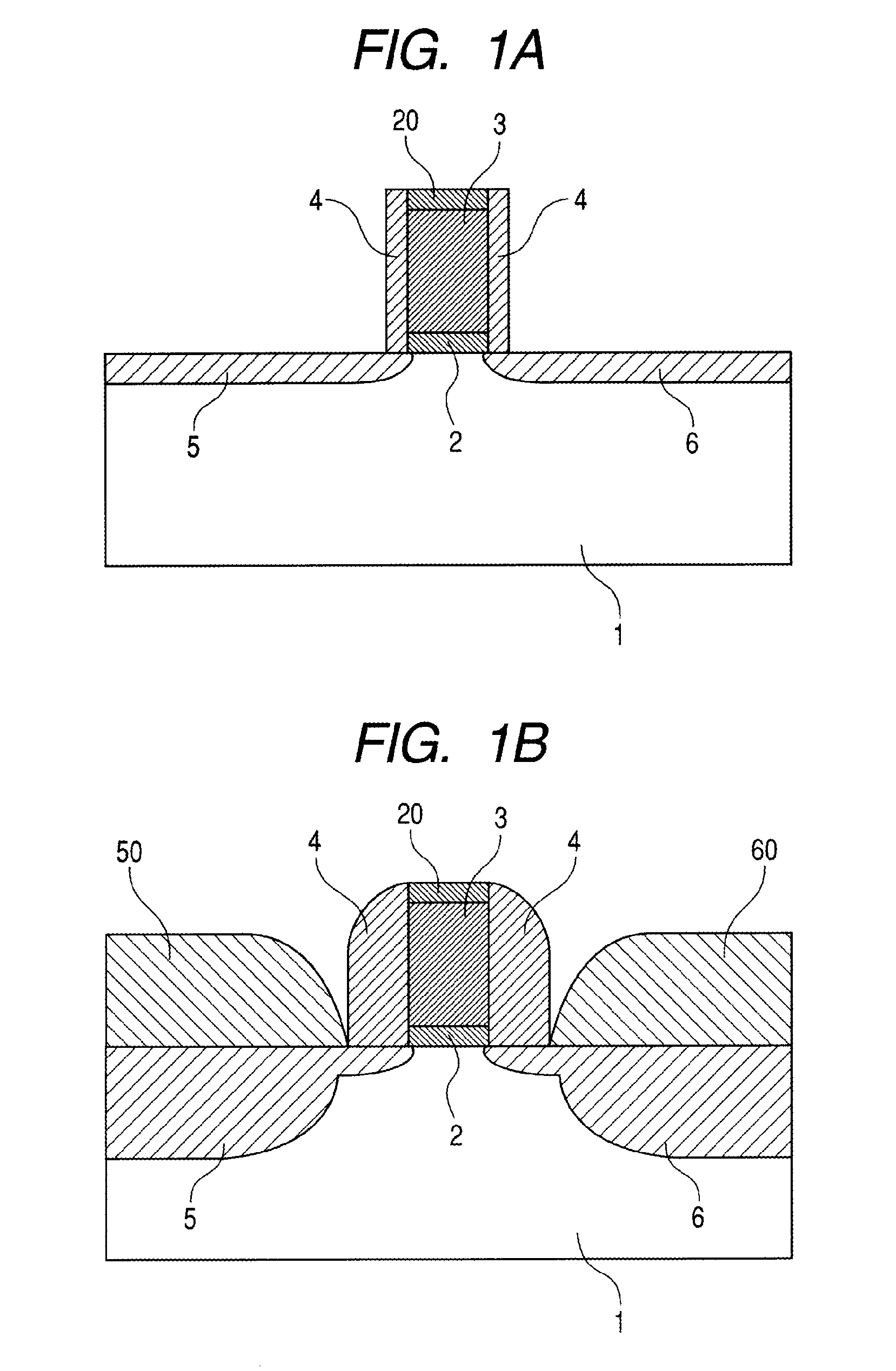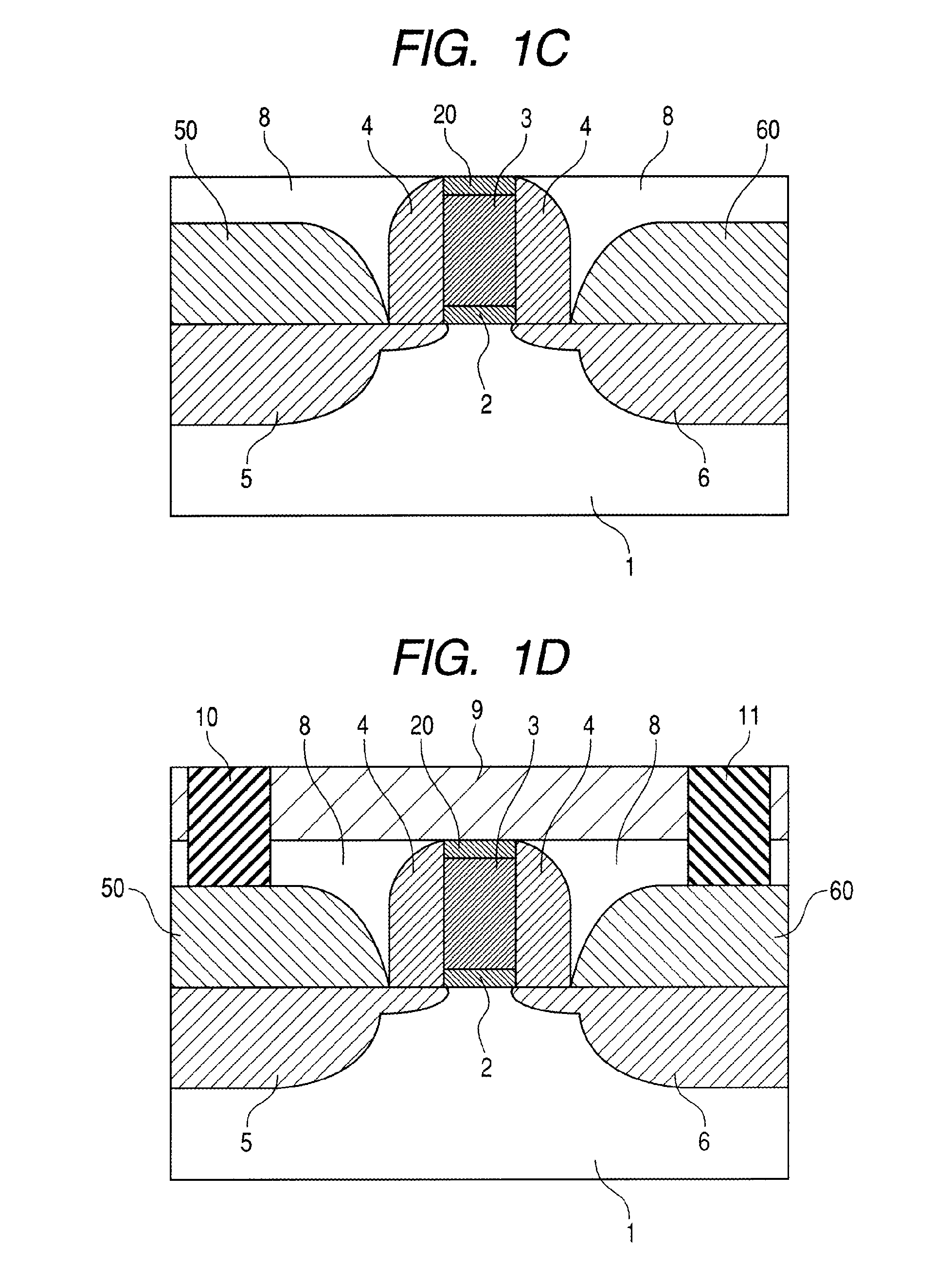Semiconductor device and production method thereof
a technology of a semiconductor device and a production method, applied in the direction of semiconductor devices, basic electric elements, electrical appliances, etc., can solve the problems of weakening of the strain in the channel region and difficulty in applying a strong strain to the channel region, and achieve the effect of improving device characteristics and strong strain
- Summary
- Abstract
- Description
- Claims
- Application Information
AI Technical Summary
Benefits of technology
Problems solved by technology
Method used
Image
Examples
first exemplary embodiment
[0045]A sectional view of an example of a semiconductor device according to a first exemplary embodiment of the present invention is shown in FIG. 1D.
[0046]As shown in the figure, a semiconductor device according to the present embodiment includes: a semiconductor substrate 1; a gate insulating film 2 formed over a first plane (a plane on the upside in the figure) of the semiconductor substrate 1; a gate electrode 3 formed over the gate insulating film 2; a gate sidewall insulating film 4 formed over the sidewall of the gate electrode 3; a source / drain diffusion layer region 5, 6, being adjacent to a channel region formed in the semiconductor substrate 1 below the gate electrode 3, into which impurities are implanted; protrusions 50 and 60 or recesses (not shown in the figure) formed in a region where the source / drain diffusion layer region 5, 6 is formed over the first plane (the plane on the upside in the figure) of the semiconductor substrate 1; and a stress applying film 8 forme...
second exemplary embodiment
[0074]The present embodiment is based on the first exemplary embodiment but the configuration of protrusions 50 and 60 is partially different from the first exemplary embodiment. The difference is explained hereunder.
[0075]A sectional view of an example of a semiconductor device according to the present embodiment is shown in FIG. 2E. Further, a top view of a structure after a gate protective film 20 and an interlayer insulating film 9 are removed in the semiconductor device shown in FIG. 2E is shown in FIG. 3. Here, FIG. 2E is a view configured by adding a gate protective film 20 and an interlayer insulating film 9 to a sectional view taken on line A-A′ of FIG. 3.
[0076]As shown in FIG. 2E, in a semiconductor device according to the present embodiment, protrusions 51 and 61 and recesses are further formed over the planes of protrusions 50 and 60 touching a stress applying film 8.
[0077]At least parts of the protrusions 51 and 61 or the recesses may extend in a direction intersecting ...
third exemplary embodiment
[0097]A perspective view of an example of a semiconductor device according to the present embodiment is shown in FIG. 7I. A part of FIG. 7I is shown as a transmissive view. Further, a perspective view of an example of a semiconductor device according to the present embodiment in the middle of the process of producing the semiconductor device shown in FIG. 7I is shown in FIG. 7C.
[0098]A semiconductor device according to the present embodiment is based on a semiconductor device according to the second exemplary embodiment but, as shown in FIG. 7C, is different from the second exemplary embodiment in the points that a first plane of the semiconductor substrate has a convex shape comprising a device layer 101 and a gate insulating film 2 is formed continuously over the upper plane and the side plane of the convex shape comprising the device layer 101.
[0099]In the case of such a semiconductor device according to the present embodiment as described above, in the same way as the second exe...
PUM
 Login to View More
Login to View More Abstract
Description
Claims
Application Information
 Login to View More
Login to View More - R&D
- Intellectual Property
- Life Sciences
- Materials
- Tech Scout
- Unparalleled Data Quality
- Higher Quality Content
- 60% Fewer Hallucinations
Browse by: Latest US Patents, China's latest patents, Technical Efficacy Thesaurus, Application Domain, Technology Topic, Popular Technical Reports.
© 2025 PatSnap. All rights reserved.Legal|Privacy policy|Modern Slavery Act Transparency Statement|Sitemap|About US| Contact US: help@patsnap.com



